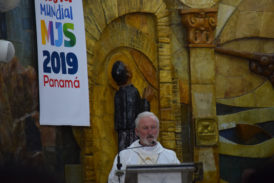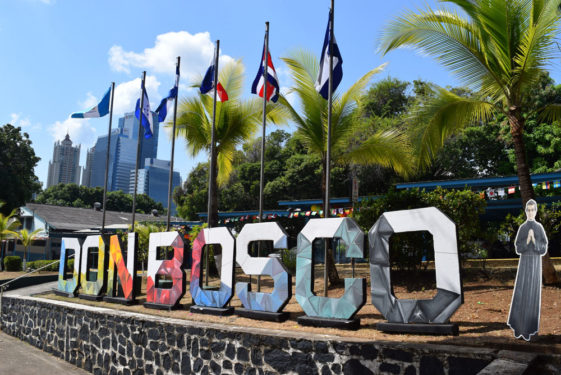World Youth Day pilgrims from Brooklyn and Queens are back in the diocese, having returned to the responsibilities of school and work, family life and social circles.
As they go about their lives, one of the memories they carry with them is of a hot and humid morning during the final day of catechesis when the perfect storm occurred. Unforeseen to the diocese’s youth ministers and staff leaders, instead of the usual international crowd that was supposed to squish into a Salesian school church for the religious teaching by Bishop Nicholas DiMarzio and Auxiliary Bishop David O’ Connell from the Archdiocese of Los Angeles, Calif., the designated audience became purely Brooklyn and Queens pilgrims with open minds and open hearts.
“To see the kids already impacted by what they have received … is a really big manifestation of the grace and the glory and the love of God,” said Panamanian Marta Cobham, who accompanied the youth from her parish at St. Athanasius, Bensonhurst. “They have gone in deep with the catechesis that we have received and each one of them had a different experience with the messages … they are discovering who God is for them and they’re embracing it in their own journey and writing their own story.”
At a moment’s notice, the youth ministry leaders combined their time, talents and improvisation skills in order to create a seamless day of connectedness within their Catholic community.
Youth minister Kenny Wodzanowski from the Bensonhurst Youth Cluster started interactive group activities. Together, they played the “Rain Dance” game and in the middle of Panama City, with no rain in the forecast, their hands and feet movements made sounds in a ripple effect that sounded like drops of water and thunder. Laughter erupted in the quaint church, located within Don Bosco Technical Institute, as pilgrims imitated each other’s hand movements and gestures.
The fun intermission allowed time for Queens’ youth ministers Angelica Taveras and Gilbert Rodriguez to setup a team for the praise and worship band for the Mass that was scheduled after catechesis.
Youth minister Romeo Petric and chaperone Karen Prizzi were also meeting and getting to know other young pilgrims from outside of their group from St. Patrick’s, Bay Ridge.
Msgr. Joseph Malagreca, pastor of Holy Cross Church, Flatbush, and coordinator of the diocesan Haitian and Hispanic Charismatic Renewal, kept a close eye on his pilgrims, some of whom he has known since they were middle-school students at SS. Joachim and Anne, Queens Village.
If the group leaders, who represented more than 15 parishes and groups across Queens or Brooklyn, planned to make the catechesis session a success, they required solidarity and support.
On the Feast of St. Paul’s conversion, the morning #WYD2019 teaching for @BrooklynDiocese was led by @BpDiMarzio who focused his talk on forgiveness. #Panama2019 pic.twitter.com/8Cn0RFYT02
— Melissa ‘Missy’ E. 🐘 (@melissamissye) January 25, 2019
“To our surprise, when we arrived, we found ourselves essentially alone,” said Diocesan Director of Youth and Young Adult Formation Paul Morisi. “There were no local leaders to welcome us or to help facilitate the day. Soon, our youth ministers mobilized and went to task. It was a proud moment for me to see leaders who I have journeyed with over the majority of my diocesan career step up to give their gifts to allow our group to have an encounter with Christ. It is a highlight of my ministry.”
For World Youth Day pilgrims, whether veteran or new to the experience, they said the small-group learning sessions were a focal point during the week. Anthony from SS. Joachim and Anne said catechesis helped him feel closer to his faith. Another pilgrim from the same parish said World Youth Day was a time he felt most connected to his diocese.

As the fun slowly came to a short stop, Bishops DiMarzio and O’Connell entered the church and approached the pulpit for the faith sharing portion of catechesis. The auxiliary bishop from Los Angeles spoke first and had a peculiar accent that differed from the Brooklyn bishop. That’s because Auxiliary Bishop O’Connell is originally from Cork, Ireland.
Neither accent nor diction took away from the overall message the two church leaders shared: forgiveness and God’s mercy amidst the “tsunami of suffering” that young adults face in today’s increasingly secular world.
The young adults were glued to the California bishop’s tall tales of ministering to gang members in South Central L.A. and how the best thing he could do for those who approach him for their pastoral needs was to tell them about Jesus’ redeeming love.
“There was this young man there and he would just never look up, he looked angry and bitter and upset all the time,” Bishop O’Connell told the pilgrims, “and I found out his name and one morning I said to him, ‘Kevin, good morning, I always see you so upset and so sad, and I said what’s wrong?’ and he said ‘I’m screaming silently inside.’”
“I figured that helped me to understand many of our young people. Many of them are ‘screaming silently inside, crying silently inside’ and it’s very sad to me what’s happened to the young people in our society.”
When it was time for Bishop DiMarzio to speak to the pilgrims from his home flock, he focused on the sacrament of reconciliation. “What can we do about confession and reconciliation?” he asked. Then he instructed all the priests who were in the church to head to the back pews and make themselves available for confession. Throughout the bishop’s talk, some pilgrims made their way to a priest – some familiar with the motions of penance, and for one pilgrim, so unfamiliar with the protocol that she told the priest she didn’t know what to do.
“It’s never too late,” said Shaba Pierre from Our Lady of Refuge, Flatbush. “Now I can go home with so much weight lifted off my shoulders. I can go home and tell people I feel clean now because not everyone is perfect.”

If renewal and second chances were the underlying highlight to the final day of catechesis, then holding the teaching session at Don Bosco Technical Institute was more than coincidence, but divine providence. And according to Panamanian-born Deacon Jaime Cobham from St. Athanasius, Don Bosco was a school that was where the local community would send their most challenging youth.
“It was one step above a correctional school,” said Deacon Cobham, “and now it’s become part of the fiber of life in the city. Our technicians are trained here and if you have a child that’s challenging and they’re going in the wrong way and they make it one year in Don Bosco, then he’s going to be a good citizen. This is a great place they’ve chosen.”
As Deacon Cobham and his wife Marta stood inside the school grounds, this homecoming for the Catholic couple symbolized a step in the positive direction not only for the youth from their parish in New York, but also for the whole surrounding community of believers not only in Panama City but also across the Central American countries.
“The Jewish community opened their synagogue for pilgrims,” said Marta. “The mosque also opened their doors as a hydration center and they are also hosting pilgrims. To see those three groups of believers, because we believe in one God, come together and support the Catholic Church in the way that they did, is awesome.That’s a different step in the unity of God’s children.”
































